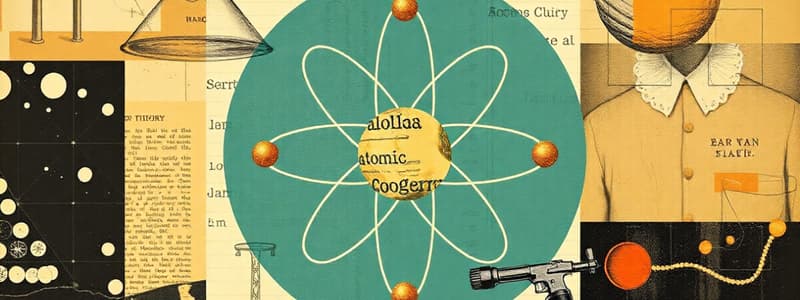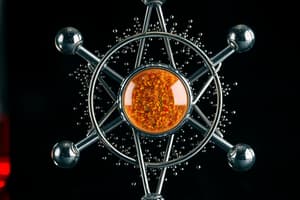Podcast
Questions and Answers
Which of the following best describes the progression of Dalton's scientific work, as evidenced by the milestones provided?
Which of the following best describes the progression of Dalton's scientific work, as evidenced by the milestones provided?
- From meteorological observations to studying gases under pressure and heat, and finally to developing a method for calculating atomic weights. (correct)
- From calculating atomic weights to studying atmospheric gases and then to receiving a Royal Society medal.
- From studying color blindness to receiving a Royal Society medal and then to formulating the law of partial pressures.
- From studying color blindness to formulating the law of partial pressures and then to calculating relative atomic weights.
Dalton's diagrams primarily served which of the following purposes in his scientific work?
Dalton's diagrams primarily served which of the following purposes in his scientific work?
- Mapping the locations of his lectures in Manchester and Cumbria, England.
- Explaining the cause and effects of color blindness that he experienced.
- Recording daily weather patterns and air pressure changes.
- Illustrating the arrangements of atoms in various elements and compounds. (correct)
How did Dalton's early interest in meteorology contribute to his atomic theory?
How did Dalton's early interest in meteorology contribute to his atomic theory?
- It inspired him to study the nature of atmospheric gases, leading to his work on partial pressures and atomic theory. (correct)
- It led him to discover new elements present in the atmosphere.
- It helped him understand color blindness.
- It prompted him to develop more accurate barometers and thermometers.
Which statement best explains the significance of Dalton receiving a Royal Society medal and becoming a member of the American Academy of Sciences?
Which statement best explains the significance of Dalton receiving a Royal Society medal and becoming a member of the American Academy of Sciences?
If Dalton used diagrams of circles to represent atoms, and Image 9 shows three circles (black with red coloring) forming a triangle, what might this suggest about Dalton's understanding?
If Dalton used diagrams of circles to represent atoms, and Image 9 shows three circles (black with red coloring) forming a triangle, what might this suggest about Dalton's understanding?
Dalton's law of partial pressures, formulated in 1803, directly relates to which aspect of his diagrams and atomic theory?
Dalton's law of partial pressures, formulated in 1803, directly relates to which aspect of his diagrams and atomic theory?
Based on the information, what was a key factor that differentiated Dalton's atomic theory from previous ideas about matter?
Based on the information, what was a key factor that differentiated Dalton's atomic theory from previous ideas about matter?
According to information provided, what experimental evidence directly supported Dalton's conclusion that atoms of different elements have different sizes and masses?
According to information provided, what experimental evidence directly supported Dalton's conclusion that atoms of different elements have different sizes and masses?
Flashcards
Dalton's Atomic Theory
Dalton's Atomic Theory
John Dalton's theory stating that all matter is composed of indivisible atoms of a given element are identical; atoms of different elements have different properties.
Law of Partial Pressures
Law of Partial Pressures
Dalton formulated this law, observing how gases are affected by pressure and heat.
Atomic Weight Calculation
Atomic Weight Calculation
The first scientific approach to calculate and chart the relative atomic weights of elements.
Atomic Size and Mass Variation
Atomic Size and Mass Variation
Signup and view all the flashcards
Dalton's Atomic Diagrams
Dalton's Atomic Diagrams
Signup and view all the flashcards
Evaporation
Evaporation
Signup and view all the flashcards
Hydrologic Cycle
Hydrologic Cycle
Signup and view all the flashcards
Rain Formation
Rain Formation
Signup and view all the flashcards




